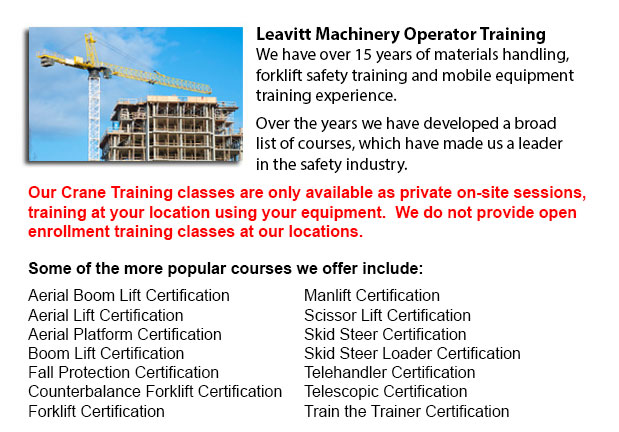
Ottawa Crane Certification - The Crane Certification training program covers content suggested by industry concerning the safe and efficient operation of cranes. Individuals training would know the following: pre-operational, operational and post operating requirements; how to identify cranes and their component parts; how to determine overall lift capacity; rigging components and inspection/rejection criteria; and requirements particular to the work place where the individuals training would be working.
The requirements which must be done before operating a crane such as assigning authority for the pre-operational check; doing the sequential pre-operational check based on the specifications certified by a professional engineer or manufacturer's specifications; inspecting the work area for obstacles and hazards; checking the log book for comments; inspecting hooks, chains, cables, crane movement and safety latches; making sure of the right functioning of operational controls; and knowing how to make sure that the crane's disconnect switch/isolator is functioning right.
Operational requirements consist of identifying responsibilities and roles, and determining the requirement for a formal lift plan. Individuals training would learn how to carry out a hazard assessment connected to environmental circumstances, physical situations and staff. Subject matter comprises determining when to seek competent assistance, the destination of loads and the safest route, and centre of gravity and load weight.
It is essential for trainees to be able to identify an over-capacity lift, select correct rigging equipment, know load restrictions, and determine a safe place from which to work. Trainees will review both site-specific and universal crane signals for lifts, and methods for traveling, lifting and loading. Correct maintenance practice would be included.
People training would be evaluated on their knowledge of the need for emergency response procedures for different circumstances such as an electrical or mechanical failure. They will be asked to describe shut down and parking procedures for safety and security, to follow tagging and lock out procedures, and to explain the reason why near misses are reported and recorded to the appropriate person. Log book records must be maintained.
Individuals training would develop knowledge of rigging, in particular, establishing who has authority and responsibility for rigging, identifying various types of rigging, knowing storage procedures and load capacity ratings.
The requirements following operation of the crane will be taught too, learning to enter the deficiencies and defects; and to log the history of maintenance and service records, based on the state, provincial and federal codes requirements.
Also, we incorporate site-specific needs to be able to meet the employers needs into our crane certification training program.
-
Ottawa Boom Lift Ticket
Ottawa Boom Lift Ticket - Boom Lifts are a table lift piece of equipment which could be lifted or lowered to varying heights, making this apparatus a useful tool for many manufacturing purposes. There are some unique types of Boom Lift consisting of... More -
Ottawa Boom Lift Operator Training
Ottawa Boom Lift Operator Training - The cherry picker work platform is a kind of work platform, which will typically have a bucket or platform at the hydraulic lifting system's end. The device is also referred to as a man lift, boom lift, basket cra... More -
Aerial Lift / Boom Lift / Man Lift / Scissor Lift Training in Ottawa
Scissor lifts are forklift tables which raise objects and people and supplies vertically. They are normally utilized in industrial, construction and commercial environments. A common use of scissor lifts is for lifting or lowering construction suppli... More -
Ottawa Heavy Equipment Training Courses
Ottawa Heavy Equipment Training Courses - The first step required to take when selecting heavy equipment operator courses is determining the capacity you wish to work with heavy machinery. Like for example, you can take courses that will teach you ho... More -
Ottawa Fall Protection Ticket
Ottawa Fall Protection Ticket - Fall-related accidents are the number one reason of death in the construction trade. The potential for fall accidents very much increases based on the kind of work which is being completed within your workplace. So, be... More -
Ottawa Telehandler Operator Training
Ottawa Telehandler Operator Training - Telescopic handler Forklifts or telehandler forklifts are common industrial machinery seen in various construction business settings. The telehandler is a useful machine and makes for a valuable tool that can be... More -
Fall Protection Training in Ottawa
Regrettably, there is a large number of workplace injuries linked to falling and lots of fall-related deaths reported each year. Lots of these instances might have been prevented by having proper measures in place, offering proper training and equipp... More -
Ottawa Heavy Equipment Operator Classes
Ottawa Heavy Equipment Operator Classes - A person who has the correct training in order to make use of a particular type or piece of equipment is called an equipment operator. There are various ways that an equipment operator can become trained to b... More

Forklift Certification Ottawa
TOLL FREE: 1-888-254-6157
Ottawa, Ontario
forkliftcertificationottawa.com
Email Us
About Us


